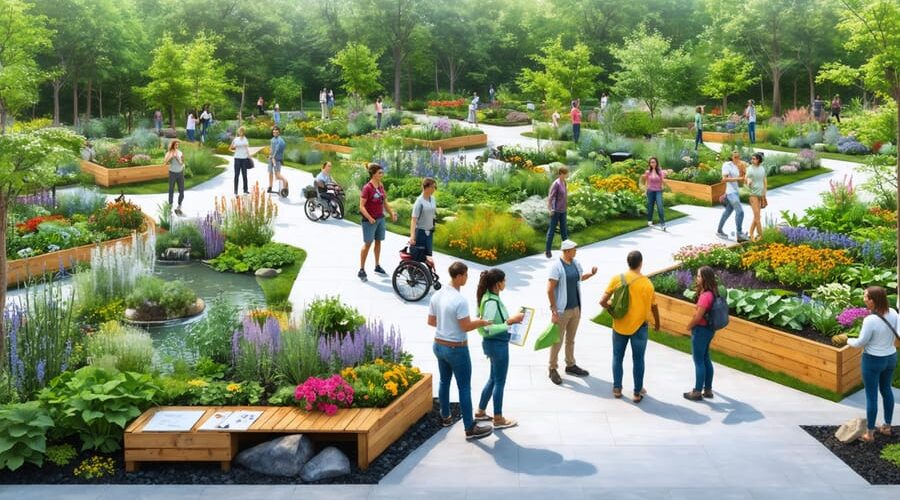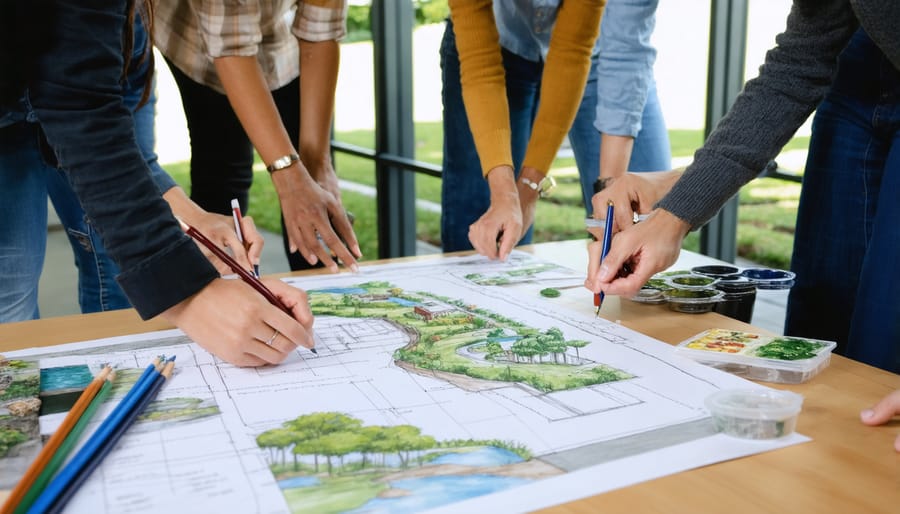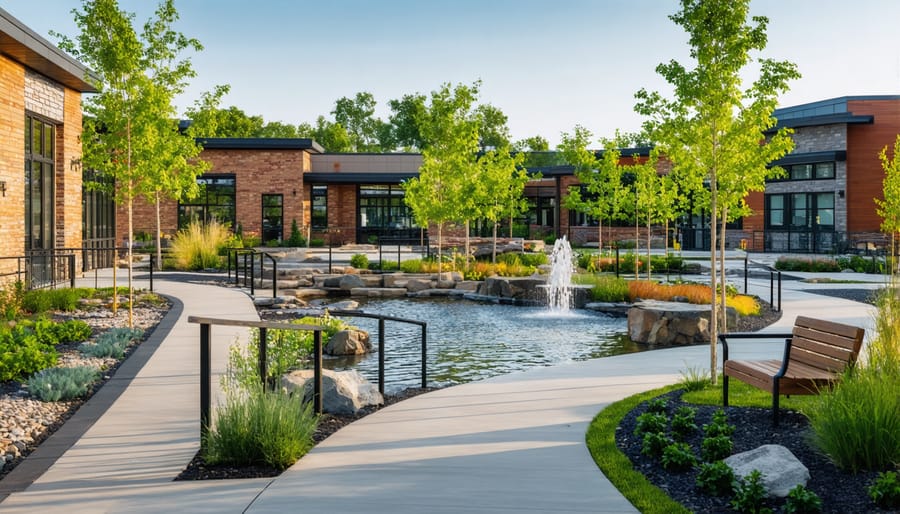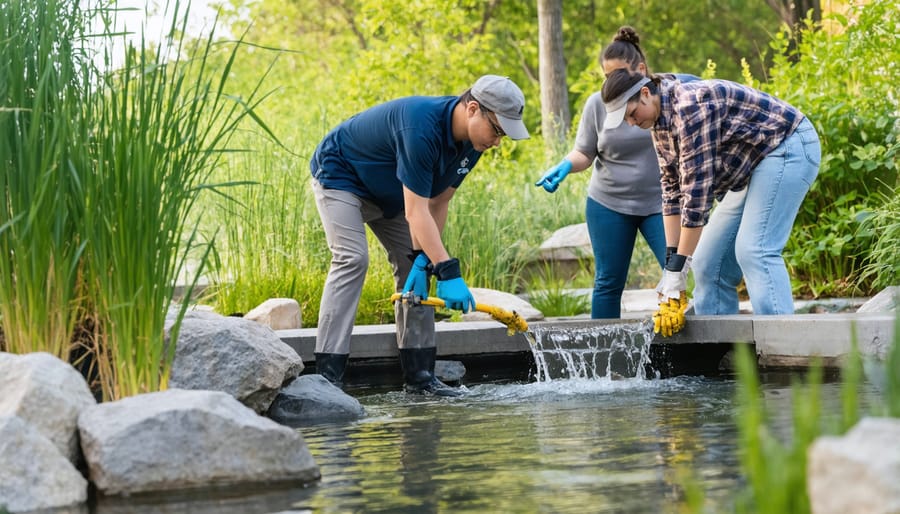
Transform Your Neighborhood: Creating a Water Garden That Brings Communities Together
Community gardens transform vacant lots into vibrant green spaces where neighbors cultivate both fresh produce and lasting friendships. These shared sanctuaries offer more than just plots of soil – they’re living laboratories where urban dwellers reconnect with nature, first-time gardeners learn from seasoned growers, and communities build resilience through sustainable food production. A well-designed community garden balances individual growing spaces with communal areas, incorporating essential features like water-efficient irrigation systems, accessible pathways, and gathering spots for educational workshops and seasonal celebrations. From raised beds bursting with heirloom vegetables to pollinator-friendly flower borders that benefit the entire neighborhood, these gardens demonstrate how shared stewardship of land can nourish both body and spirit while creating stronger, more connected communities. Understanding the key elements of successful community gardens helps organizers create spaces that serve diverse needs while fostering environmental awareness and social bonds that grow deeper with each passing season.
Building the Foundation: Community Input and Design Planning
Organizing Community Design Workshops
Community design workshops are essential for creating gardens that truly reflect everyone’s needs and desires. Start by scheduling multiple workshop sessions at convenient times to maximize participation. Consider hosting both weekday evening and weekend sessions to accommodate different schedules. Before the workshops, prepare visual aids like garden layout templates, plant catalogs, and photos of successful community gardens to inspire ideas.
During these hands-on workshop planning sessions, use interactive methods like sticky note brainstorming, where participants can write their ideas and preferences for garden features. Create small breakout groups to discuss specific aspects like plant selection, water features, and seating areas. Use simple surveys to gather structured feedback about priorities and concerns.
Make sure to include activities that engage different age groups and abilities. Children might enjoy drawing their dream garden, while older participants might prefer discussing practical maintenance considerations. Document all suggestions and create a summary to share with the community. This inclusive approach helps build consensus and ensures everyone feels invested in the final garden design.

Balancing Different Needs and Visions
Creating a harmonious community garden means embracing different visions while working toward a shared goal. Start by holding open discussions where everyone can share their ideas and preferences. Consider using visual aids like mood boards or garden sketches to help members communicate their vision more effectively.
Break down the garden into distinct zones that can accommodate various preferences. For example, some members might prefer traditional flower beds, while others want vegetable plots or water features. This approach allows for personal expression while maintaining overall cohesion.
Establish a democratic decision-making process for major design choices. Consider forming a design committee that represents different garden interests and rotates membership regularly. When conflicts arise, focus on finding compromise solutions that incorporate elements from multiple suggestions.
Remember that diversity in design can actually strengthen the garden’s appeal and functionality. Mixed-use spaces often create more interesting and dynamic environments that serve the community better than uniform layouts. Keep communication channels open and regularly review and adjust plans based on community feedback and changing needs.
Essential Design Elements for Community Water Gardens
Accessibility and Safety Features
Our community garden prioritizes inclusivity and safety, ensuring everyone can enjoy the space comfortably. Wide, stable pathways constructed from non-slip materials accommodate wheelchairs and mobility aids, while strategic lighting illuminates walkways for evening access. Raised garden beds at various heights allow gardeners of all abilities to tend their plots without strain, and wheelchair-accessible water features make sustainable water garden design accessible to all.
Safety features include clearly marked edges around water features, sturdy handrails along steps and slopes, and emergency contact information displayed prominently throughout the garden. We’ve installed multiple rest areas with comfortable seating, providing spaces for gardeners to take breaks and socialize. These areas also serve as meeting points and shelter from weather elements.
The garden’s layout incorporates wide turning spaces at pathway intersections and gentle slopes instead of steps where possible. Tool storage areas are positioned at accessible heights, and we maintain a collection of adaptive gardening tools. Educational signage uses large, clear fonts and includes tactile elements for visually impaired visitors. Regular maintenance checks ensure all safety features remain in good working order, while volunteer safety wardens help maintain a secure environment during peak hours.

Maintenance-Friendly Design Choices
Our community garden incorporates several smart design features that make group maintenance a breeze. Wide, mulched pathways between plots allow easy access with wheelbarrows and garden carts, while communal tool storage sheds are strategically placed to minimize walking distances. Raised beds with built-in irrigation systems reduce watering time and ensure consistent moisture levels across all plots.
The garden’s layout includes designated composting stations near each major section, making it convenient for gardeners to manage organic waste. Weather-resistant bulletin boards positioned at key entry points help coordinate maintenance schedules and communicate important updates to all members.
To simplify ongoing care, we’ve installed durable edging materials that prevent grass invasion and reduce weeding time. The garden features central water spigots with multiple hose connections, eliminating conflicts over watering access during peak times. Motion-sensor lighting around common areas ensures safe access during early morning or evening maintenance sessions.
Our tool-sharing system includes clearly labeled storage spaces and a sign-out board, promoting responsible equipment use and maintenance. The garden’s perimeter features low-maintenance native plants that act as natural windbreaks and attract beneficial insects, while requiring minimal upkeep from the community.
For seasonal transitions, we’ve incorporated easily accessible cleanup zones and yard waste collection areas, streamlining the process of garden bed turnover and communal space maintenance.
Managing Shared Resources and Responsibilities

Creating Maintenance Schedules
A well-organized maintenance schedule is crucial for keeping your community garden thriving throughout the year. Start by creating a shared digital calendar that all garden members can access and update. Popular tools like Google Calendar or gardening-specific apps work well for coordinating tasks and ensuring everyone stays informed.
Break down maintenance duties into daily, weekly, and monthly tasks. Daily responsibilities might include watering and basic clean-up, while weekly tasks could cover weeding and pest monitoring. Monthly duties often involve fertilizing, pruning, and seasonal preparations.
Consider implementing a rotating schedule where members take turns handling different responsibilities. A simple approach is assigning each member specific days of the week or dividing the garden into sections that rotate between teams. This prevents burnout and ensures everyone contributes fairly to the garden’s upkeep.
Create clear task checklists for each maintenance duty to maintain consistent care standards. Include specific instructions like “water deeply around plant bases” or “check compost moisture levels” to help even novice gardeners contribute effectively.
Don’t forget to account for seasonal variations in your schedule. Spring and summer typically require more frequent maintenance than fall and winter. Build in flexibility for weather-related changes and unexpected garden needs.
Track completion of tasks using a shared log or digital tool. This helps identify any gaps in maintenance and allows the community to adjust schedules as needed. Regular monthly meetings can help address any scheduling challenges and ensure the system works for everyone involved.
Remember to celebrate your garden’s successes and thank volunteers regularly. Recognition helps maintain enthusiasm and creates a positive community atmosphere around garden maintenance duties.
Resource Allocation and Cost Sharing
Managing shared resources in a community garden requires thoughtful planning and fair distribution systems. One of the most effective approaches is implementing efficient resource management systems that track both expenses and usage.
Most successful community gardens operate on a membership fee structure, where participants contribute annually or seasonally. These fees typically cover basic maintenance costs, water bills, and shared tools. A transparent budget helps members understand how their contributions are used and builds trust within the community.
Consider creating a shared tool shed where members can access essential gardening equipment. Implement a sign-out system for expensive items like water pumps or specialized tools. Many gardens find success with a cooperative approach where members contribute specific tools to the communal collection.
Water costs can be managed through smart scheduling and fair usage policies. Some gardens assign specific watering days to different plots, while others install water meters for usage-based billing. Installing rain barrels and implementing water-wise gardening practices can significantly reduce costs for everyone.
For consumable resources like mulch, compost, or seasonal supplies, many gardens organize bulk purchases to secure better prices. Creating a rotating schedule for maintenance tasks helps distribute the workload evenly and ensures everyone contributes their fair share to the garden’s upkeep.
Remember to set aside a portion of collected fees for emergency repairs and future improvements. This creates a sustainable financial foundation for your community garden’s long-term success.
Creating a community water garden is more than just building a beautiful outdoor space – it’s about fostering connections, sharing knowledge, and working together toward a common goal. Throughout this guide, we’ve explored the essential elements of designing, maintaining, and managing a successful community water garden, from selecting the right location to establishing clear guidelines for participation.
Remember that the most thriving community gardens are those where everyone feels invested and valued. Whether you’re just starting or looking to enhance an existing space, consider organizing regular meetings, workshops, and social events to keep members engaged and build a strong sense of community.
Don’t be afraid to start small and grow gradually. Begin with simple water features and expand as your community’s expertise and resources grow. Share your successes and challenges with other community gardens, and stay open to learning from their experiences.
Ready to make a splash in your community? Take that first step today by reaching out to local gardening groups or organizing a neighborhood meeting. Your future oasis of tranquility and community spirit awaits!
